Assessment of Fatigue Life and Failure Criteria in Ultrasonic Testing Through Thermal Analyses
Abstract
:1. Introduction
- Conducting experimental tests under various stress levels and intermittent loading conditions (different pulse and pause times) while monitoring temperatures using infrared (IR) thermography to develop temperature (T)–number of cycles (N) curves.
- Estimating temperature gradients at the onset of fatigue testing (RΘ) from the T–N curves and analyzing their dependence on stress levels and effective frequency (feff).
- Deriving S–N curves independent of temperature effects.
- Applying fatigue failure criteria models to ultrasonic frequency test results to identify the model that best aligns with experimental data and determine the most suitable parameters for representing fatigue damage in VHCF testing.
2. Fundamentals for Fatigue and Temperature Rise
- Phase I: At the start of the test, the specimen’s temperature rises rapidly from the initial room temperature (T0) to the stabilized or steady-state temperature (Ts).
- Phase II: The temperature variation is minimal, indicating that the specimen has reached the steady-state temperature (Ts). According to the literature, this phase accounts for the majority of the specimen’s fatigue life.
- Phase III: The temperature rises sharply again but over a relatively small number of cycles. This phase marks the conclusion of the fatigue test, culminating in the specimen’s fracture.
3. Materials and Methods
3.1. Materials
3.2. Methods
4. Results
4.1. T–N Curves
4.2. S–N Curve
4.3. Model Evaluation
4.4. Fracture Surfaces
5. Conclusions
- In all T–N curves, temperature increases were observed as test time decreased.
- Specimens tested with intermittent loads of 300–200, 200–200, and 200–300 ms at stress levels of 40% and 45% σu showed that the maximum temperature exceeded 300 °C.
- Fatigue life was shortened in these cases compared with tests with a 300–500 ms pulse–pause time due to high temperatures.
- The steady-state temperature was not clearly defined for specimens that failed before reaching 107 cycles.
- Specimens experienced an increase in surface temperature in relation to feff for a constant σa.
- Higher values of feff and σa led to a steeper temperature slope at the start of the test.
- S–N Curve and Fatigue Life:
- An S–N curve was obtained under 300–500 ms pulse–pause conditions, exhibiting a higher level of scatter, as expected.
- The maximum temperature observed during these loadings was below 40 °C.
- The Jiang and Fargione models were found to be unsuitable for the experimental conditions of this study.
- The Qcyc-Nf and Rϴ-Nf curves aligned with those found in the literature for low-frequency tests, indicating that Nf increases as Qcyc and Rϴ decrease.
- Fatigue functions for both models were derived, with predicted results showing good accuracy compared with experimental tests.
- High scatter in ultrasonic fatigue tests may influence results.
- The Meneghetti and Amiri-Khonsari models showed strong potential for predicting fatigue life based on temperature, even under VHCF conditions.
- Some specimens exhibited burning on the crack surfaces due to high temperatures, negatively impacting their fatigue performance.
- A cooling system is essential for VHCF tests to manage high temperatures.
- Depending on the material studied, it may be necessary to increase pause times to maintain temperature control.
- An additional cooling mechanism may be required to keep the test at room temperature.
Author Contributions
Funding
Institutional Review Board Statement
Informed Consent Statement
Data Availability Statement
Acknowledgments
Conflicts of Interest
References
- Suresh, S. Fatigue of Materials; Cambridge University Press: New York, NY, USA, 1998. [Google Scholar]
- Downling, N.E. Mechanical Behavior of Materials: Engineering Methods for Deformation, Fracture, and Fatigue, 4th ed.; Pearson Education: Upper Saddle River, NJ, USA, 2012. [Google Scholar]
- Bathias, C.; Paris, P.C. Gigacycle Fatigue in Mechanical Practice; Informa UK Limited: London, UK, 2005. [Google Scholar]
- Bathias, C. There is no infinite fatigue life in metallic materials. Fatigue Fract. Eng. Mater Struct. 1999, 22, 559–565. [Google Scholar] [CrossRef]
- Kazymyrovych, V. Very high cycle fatigue of engineering materials: A literature review. Mater. Sci. Eng. 2009. [Google Scholar]
- Teixeira, M.C.; Brandão, A.L.T.; Parente, A.P.; Pereira, M.V. Artificial intelligence modeling of ultrasonic fatigue test to predict the temperature increase. Int. J. Fatigue 2022, 163, 106999. [Google Scholar] [CrossRef]
- Jeddi, D.; Palin-Luc, T. A review about the effects of structural and operational factors on the gigacycle fatigue of steels. Fatigue Fract. Eng. Mater Struct. 2018, 41, 969–990. [Google Scholar] [CrossRef]
- Crupi, V.; Epasto, G.; Guglielmino, E.; Risitano, G. Analysis of temperature and fracture surface of AISI4140 steel in very high cycle fatigue regime. Theor. Appl. Fract. Mech. 2015, 80, 22–30. [Google Scholar] [CrossRef]
- Peng, W.; Zhang, Y.; Qiu, B.; Xue, H. A Brief Review of the Application and Problems in Ultrasonic Fatigue Testing. AASRI Procedia 2012, 2, 127–133. [Google Scholar] [CrossRef]
- Ebara, R. The present situation and future problems in ultrasonic fatigue testing—Mainly reviewed on environmental effects and materials’ screening. Int. J. Fatigue 2006, 28, 1465–1470. [Google Scholar] [CrossRef]
- Peng, W.; Xue, H.; Ge, R.; Peng, Z. The influential factors on very high cycle fatigue testing results. MATEC Web Conf. 2018, 165, 20002. [Google Scholar]
- Lee, H.W.; Basaran, C. Predicting high cycle fatigue life with unified mechanics theory. Mech. Mater. 2022, 164, 104116. [Google Scholar] [CrossRef]
- Ellyin, F. Fatigue Damage, Crack Growth and Life Prediction; Springer Nature: Dordrecht, The Netherlands, 1996. [Google Scholar]
- Halford, G.R. The energy required for fatigue. J. Mater. 1966, 1, 3–18. [Google Scholar]
- Meneghetti, G.; Ricotta, M. The use of the specific heat loss to analyse the low and high cycle fatigue behavior of plain and notched specimens made of a stainless steel. Eng. Fract. Mech. 2012, 81, 2–16. [Google Scholar] [CrossRef]
- Amiri, M.; Khonsari, M.M. Introduction to Thermodynamics of Mechanical Fatigue; CRC Press: Boca Raton, FL, USA, 2013. [Google Scholar]
- Ricotta, M.; Meneghetti, G.; Atzori, B.; Risitano, G.; Risitano, A. Comparison of Experimental Thermal Methods for the Fatigue Limit Evaluation of a Stainless Steel. Metals 2019, 9, 677. [Google Scholar] [CrossRef]
- Meneghetti, G. Analysis of the fatigue strength of a stainless steel based on the energy dissipation. Int. J. Fatigue 2007, 29, 81–94. [Google Scholar] [CrossRef]
- Meneghetti, G.; Ricotta, M.; Atzori, B. A synthesis of the push-pull fatigue behavior of plain and notched stainless steel specimens by using the specific heat loss. Fatigue Fract. Eng. Mater Struct. 2013, 36, 1306–1322. [Google Scholar] [CrossRef]
- Amiri, M.; Khonsari, M.M. Rapid determination of fatigue failure based on temperature evolution: Fully reversed bending load. Int. J. Fatigue 2010, 32, 382–389. [Google Scholar] [CrossRef]
- Jiang, J.Y.; Khonsari, M.M. On the evaluation of fracture fatigue entropy. Theor. Appl. Fract. Mech. 2018, 96, 351–361. [Google Scholar] [CrossRef]
- Jiang, L.; Wang, H.; Liaw, P.K.; Brooks, C.R.; Klarstrom, D.L. Characterizartion of the temperatura evolution during high cycle fatigue. Metall. Mater. Trans. A 2001, 32, 2279–2296. [Google Scholar] [CrossRef]
- Fargione, G.; Geraci, A.; La Rosa, G.; Risitano, A. Rapid determination of the fatigue curve by thermographic method. Int. J. Fatigue 2002, 24, 11–19. [Google Scholar] [CrossRef]
- Sakai, T.; Nakagawa, A.; Oguma, N.; Nakamura, Y.; Ueno, A.; Kikuchi, S.; Sakaida, A. A review on fatigue fracture modes of structural metallic materials in very high cycle regime. Int. J. Fatigue 2016, 93, 339–351. [Google Scholar] [CrossRef]
- Wang, L.; Qian, X. Optimization-improved thermal–mechanical simulation of welding residual stresses in welded connections. Comput. Aided Civ. Infrastruct. Eng. 2024, 39, 1275–1293. [Google Scholar] [CrossRef]
- Wang, L.; Qian, X.; Feng, L. Effect of welding residual stresses on the fatigue life assessment of welded connections. Int. J. Fatigue 2024, 189, 108570. [Google Scholar] [CrossRef]
- Wang, L.; Qian, X. Welding residual stresses and their relaxation under cyclic loading in welded S550 steel plates. Int. J. Fatigue 2022, 162, 106992. [Google Scholar] [CrossRef]
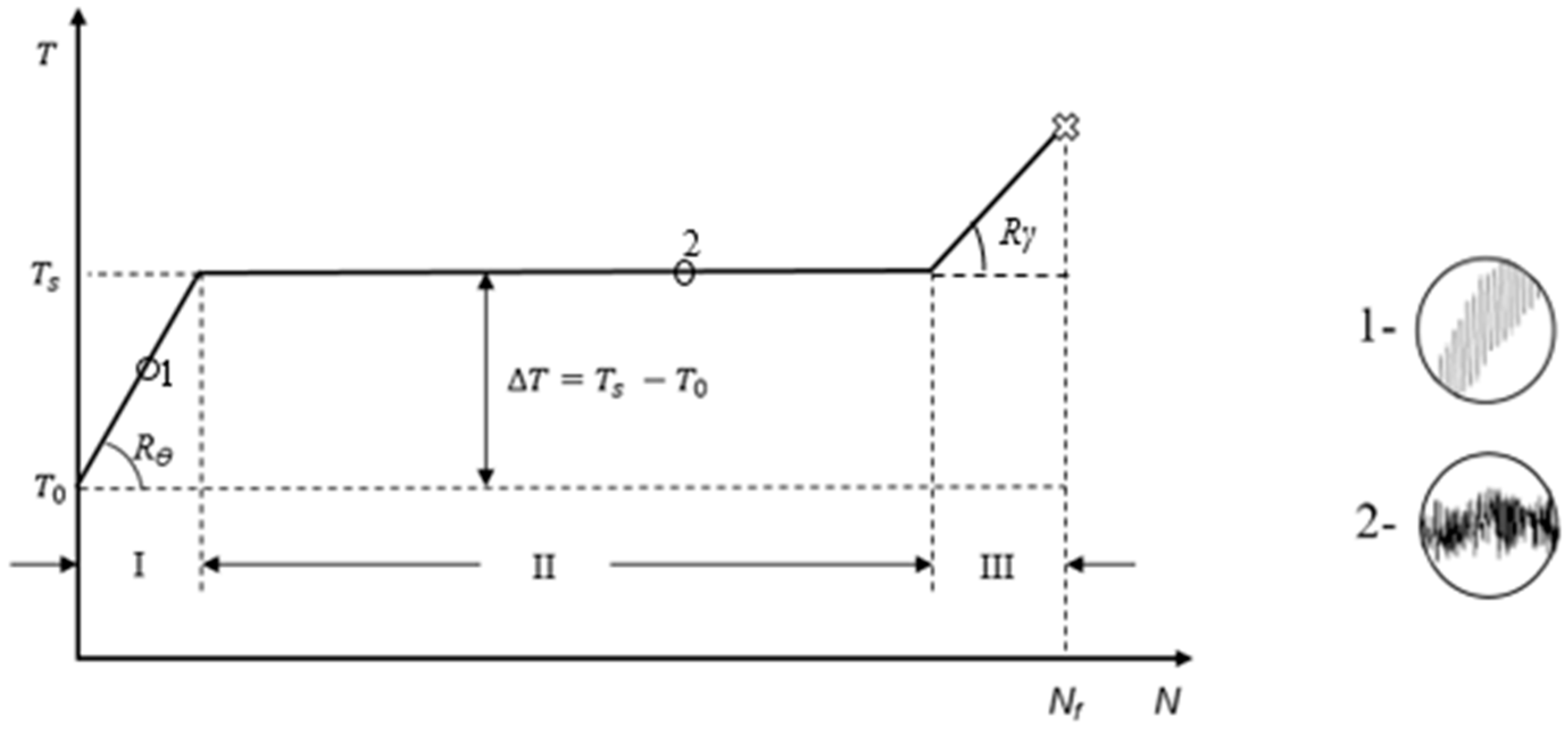


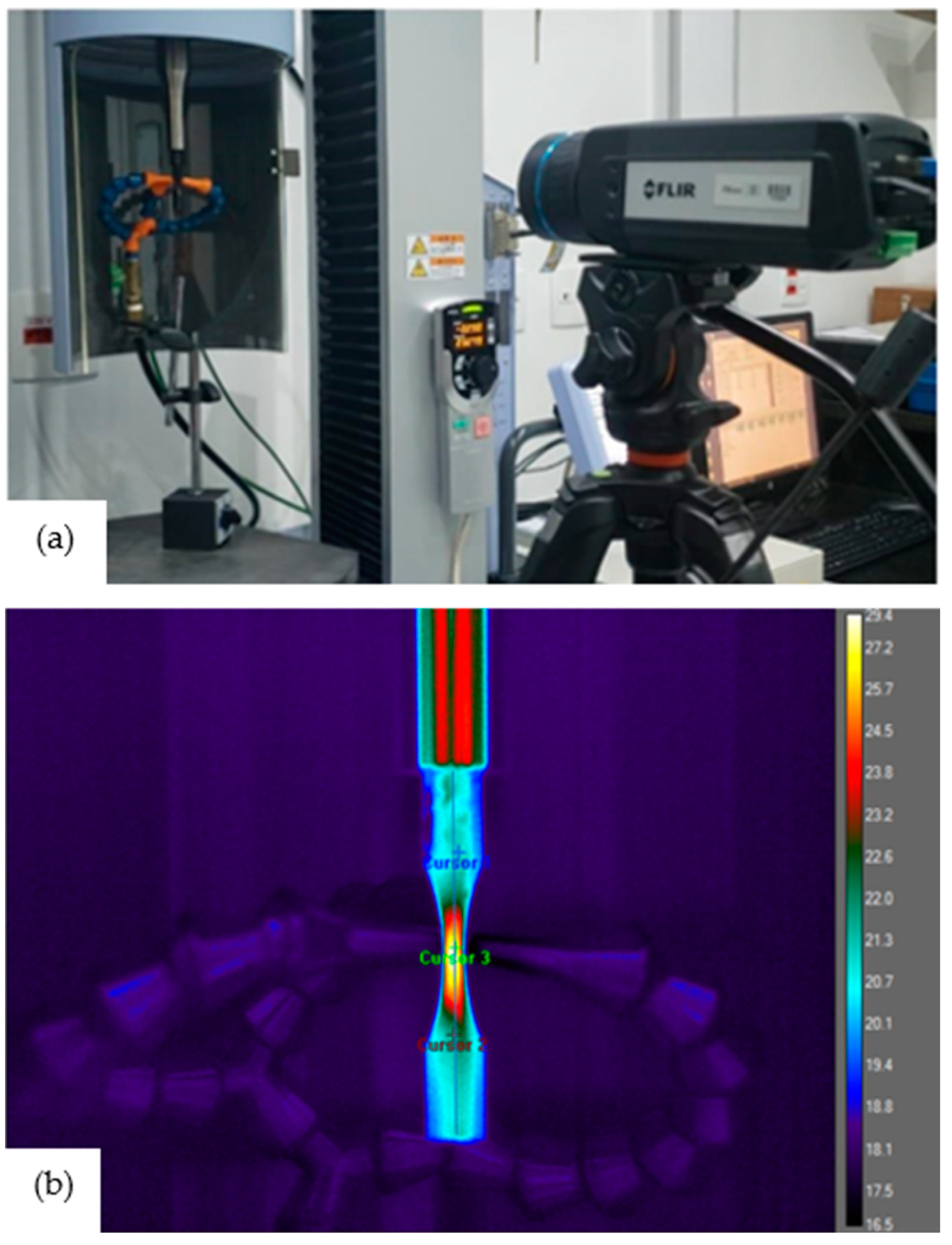


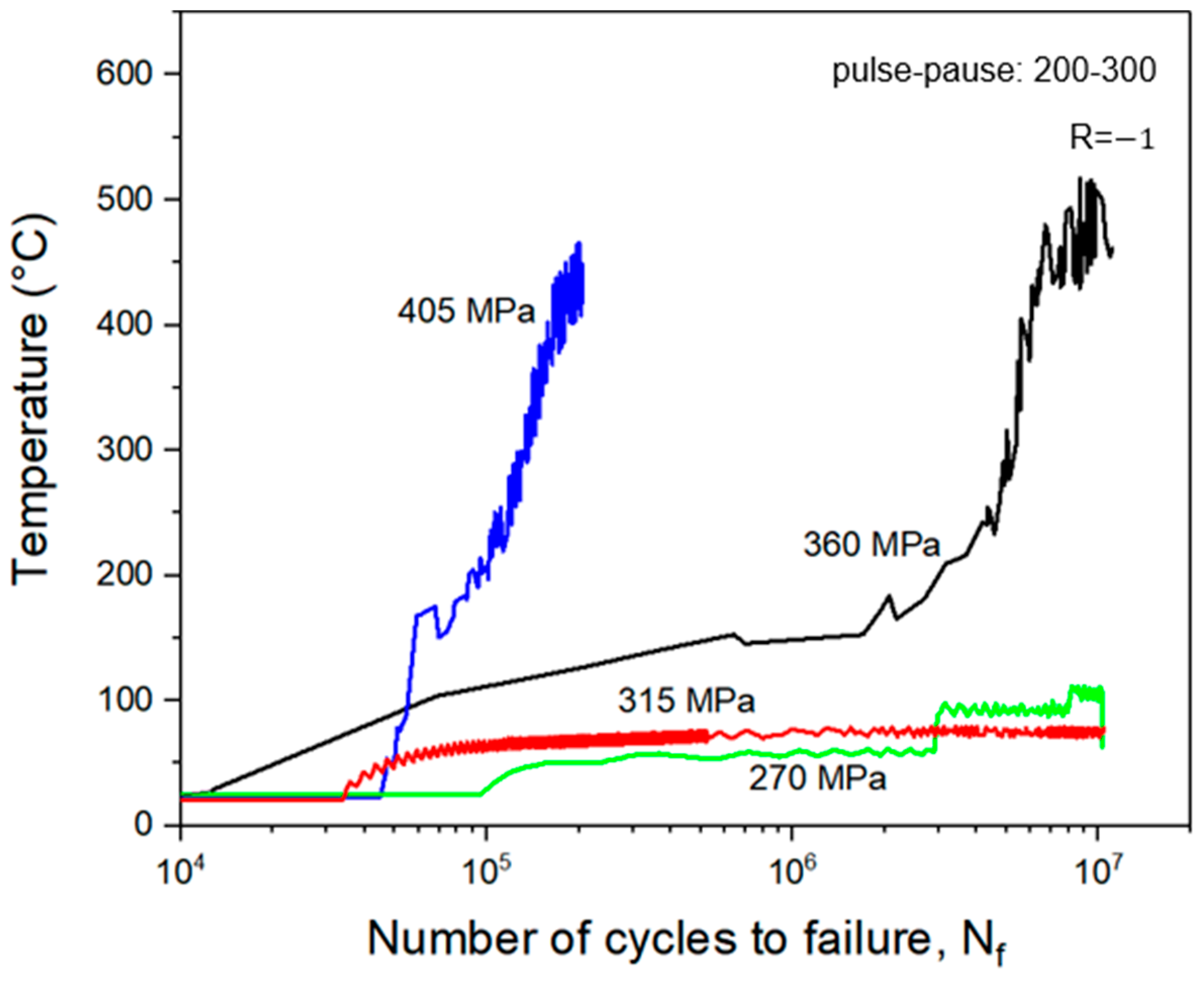
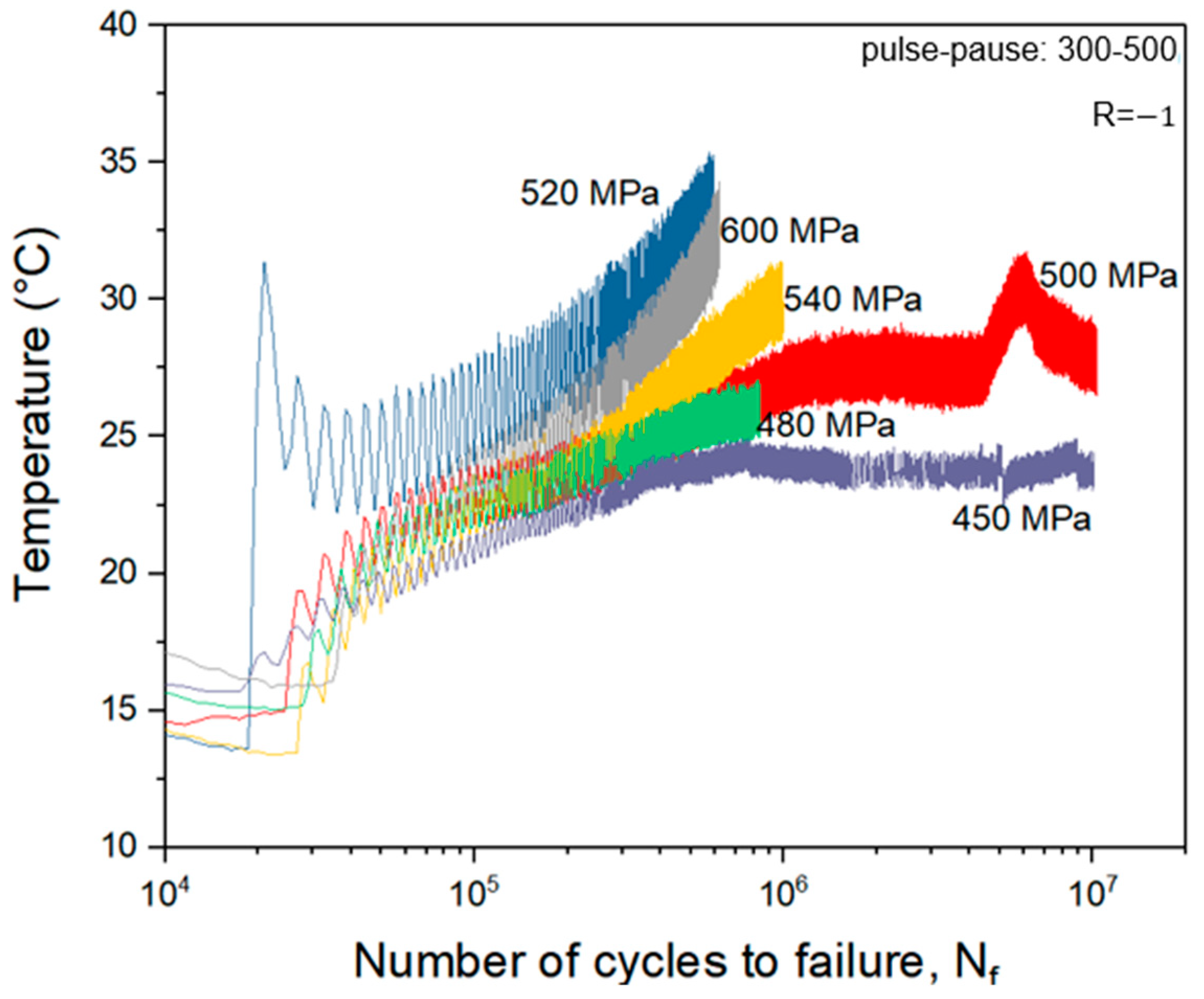
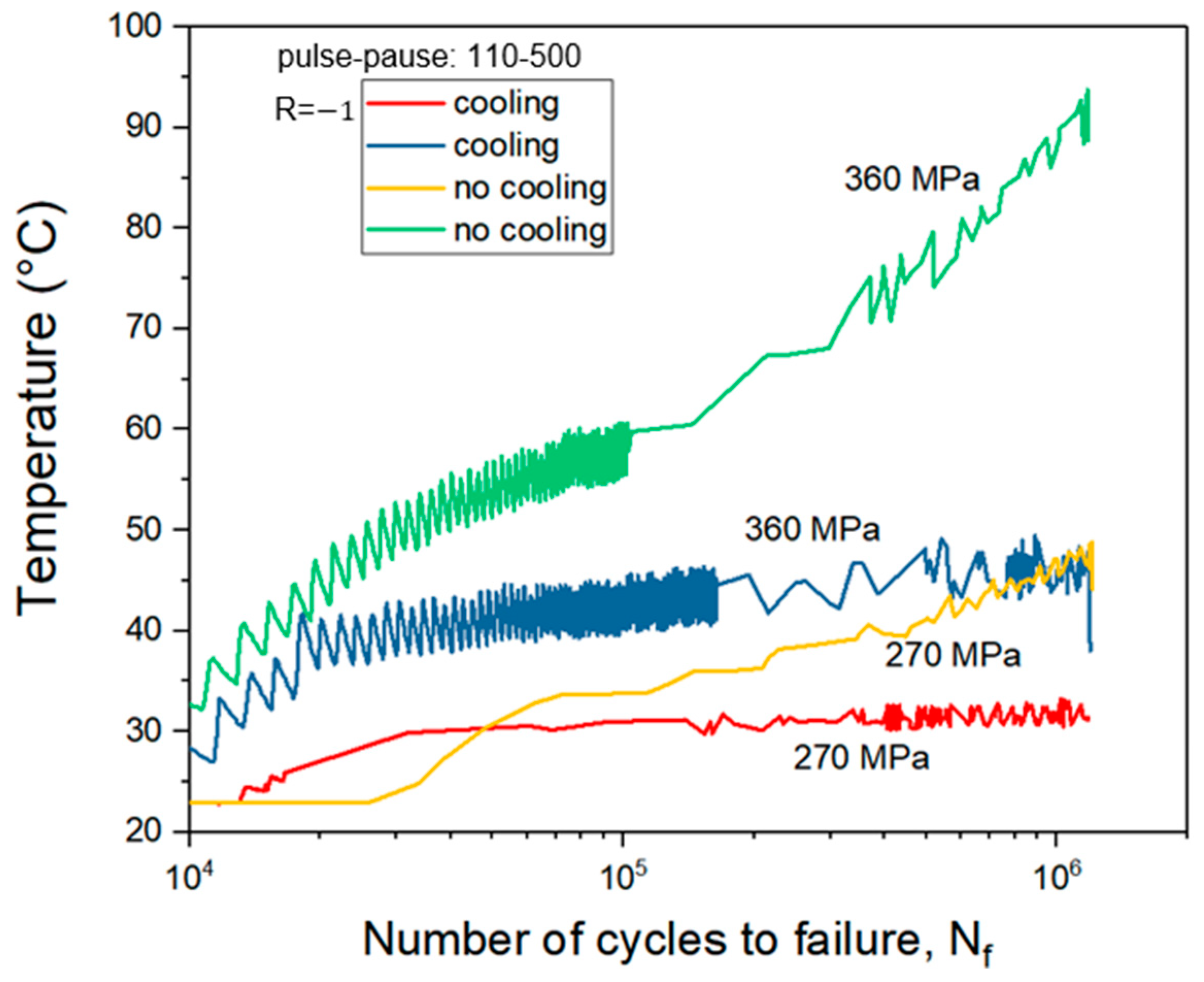

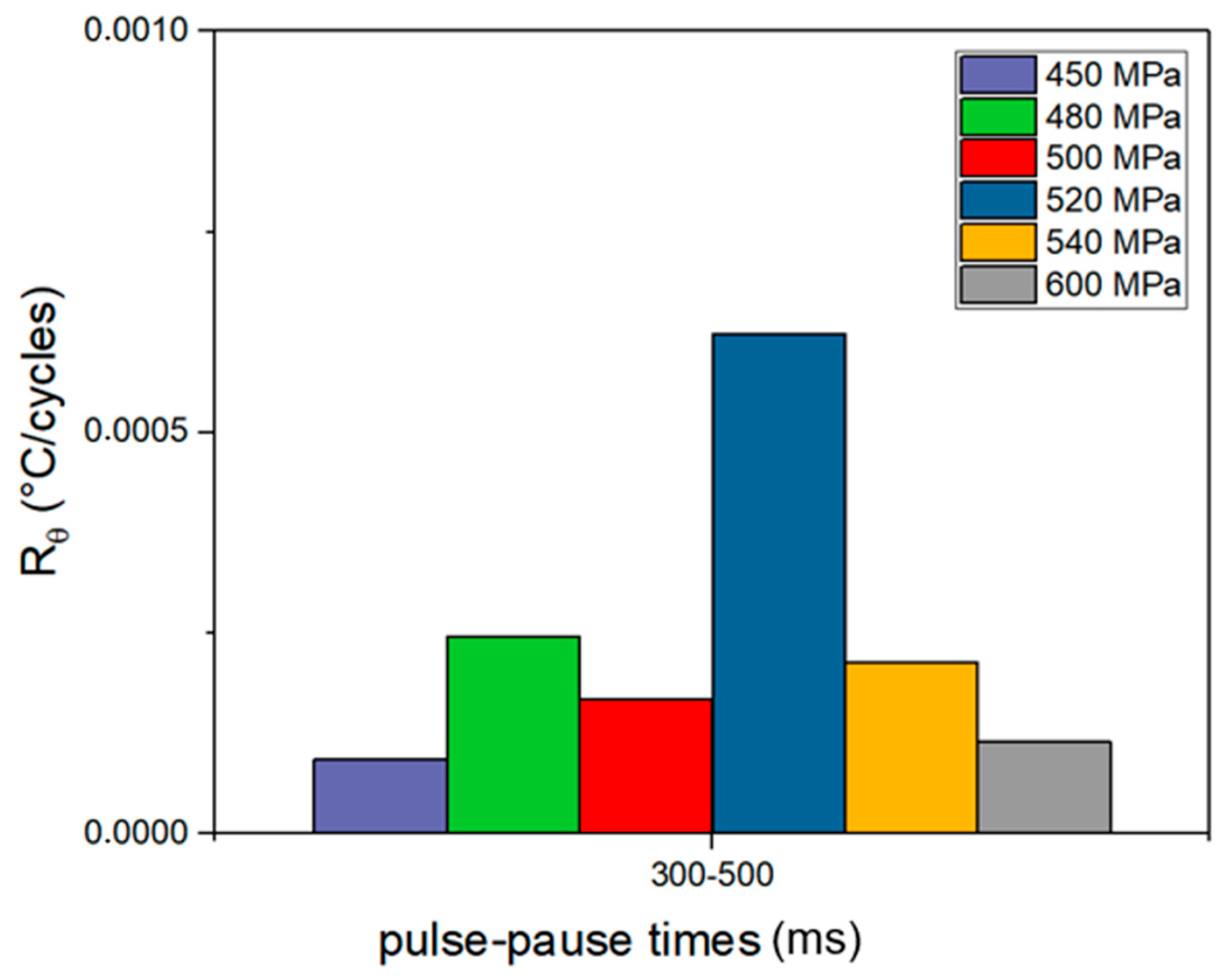
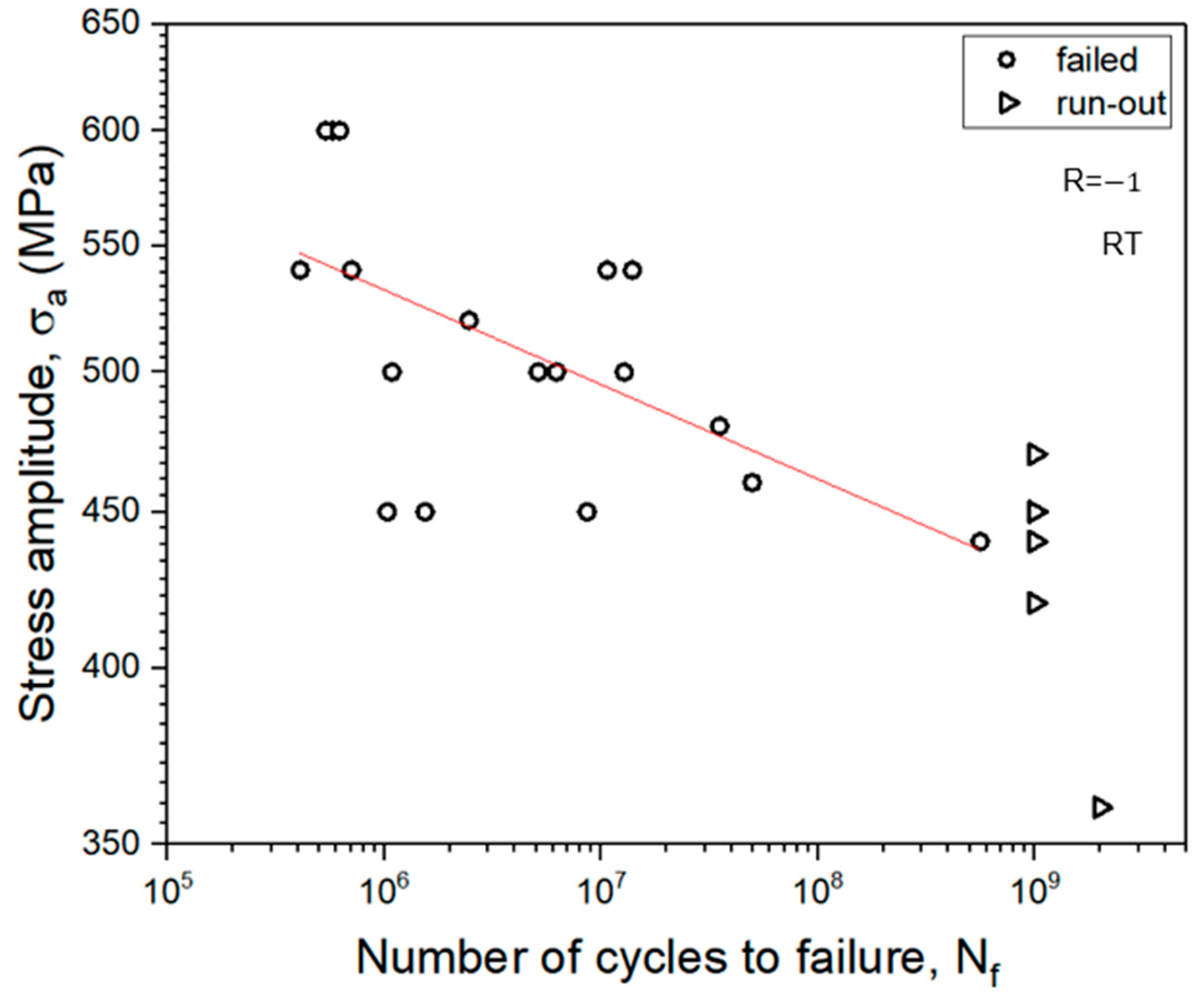

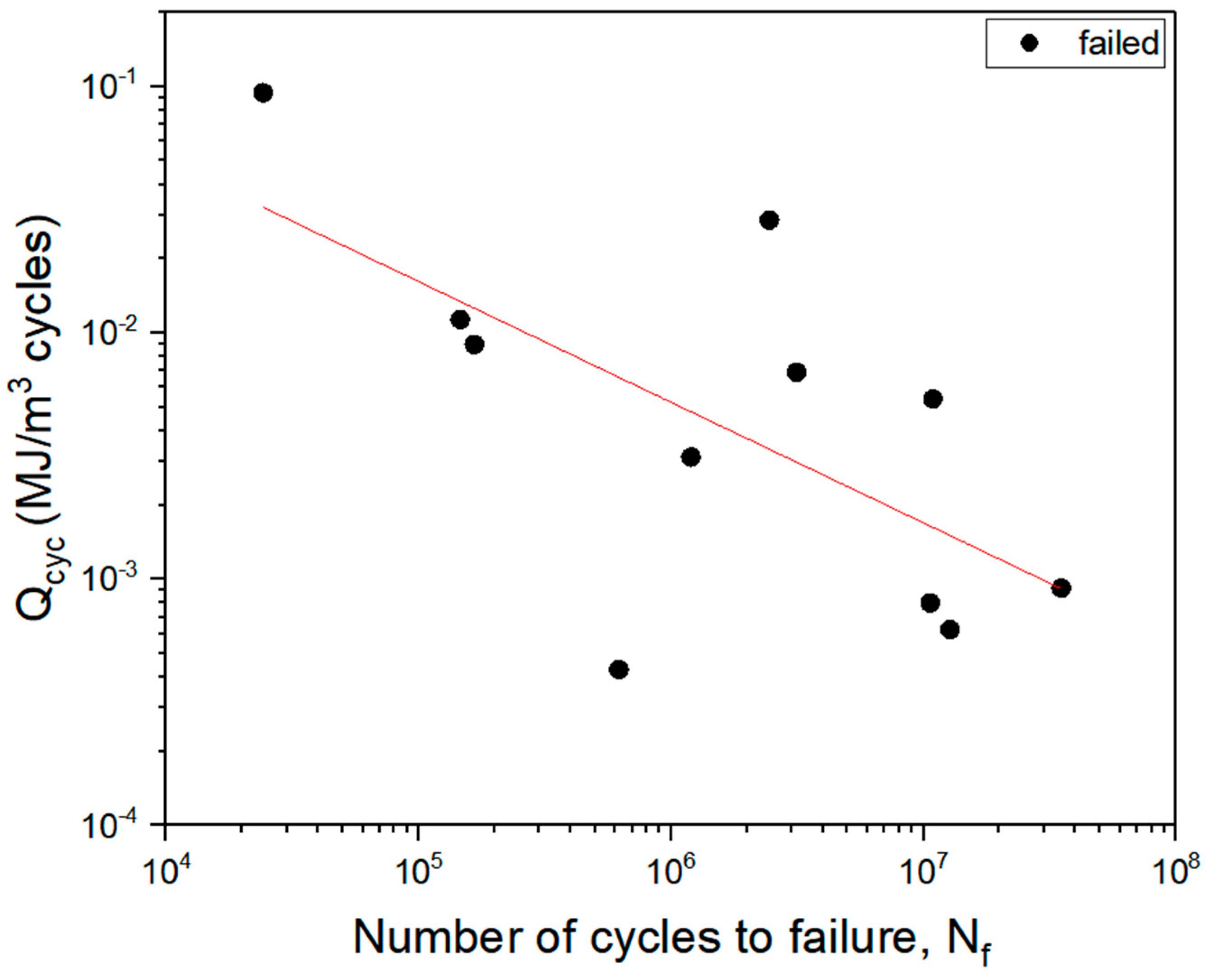
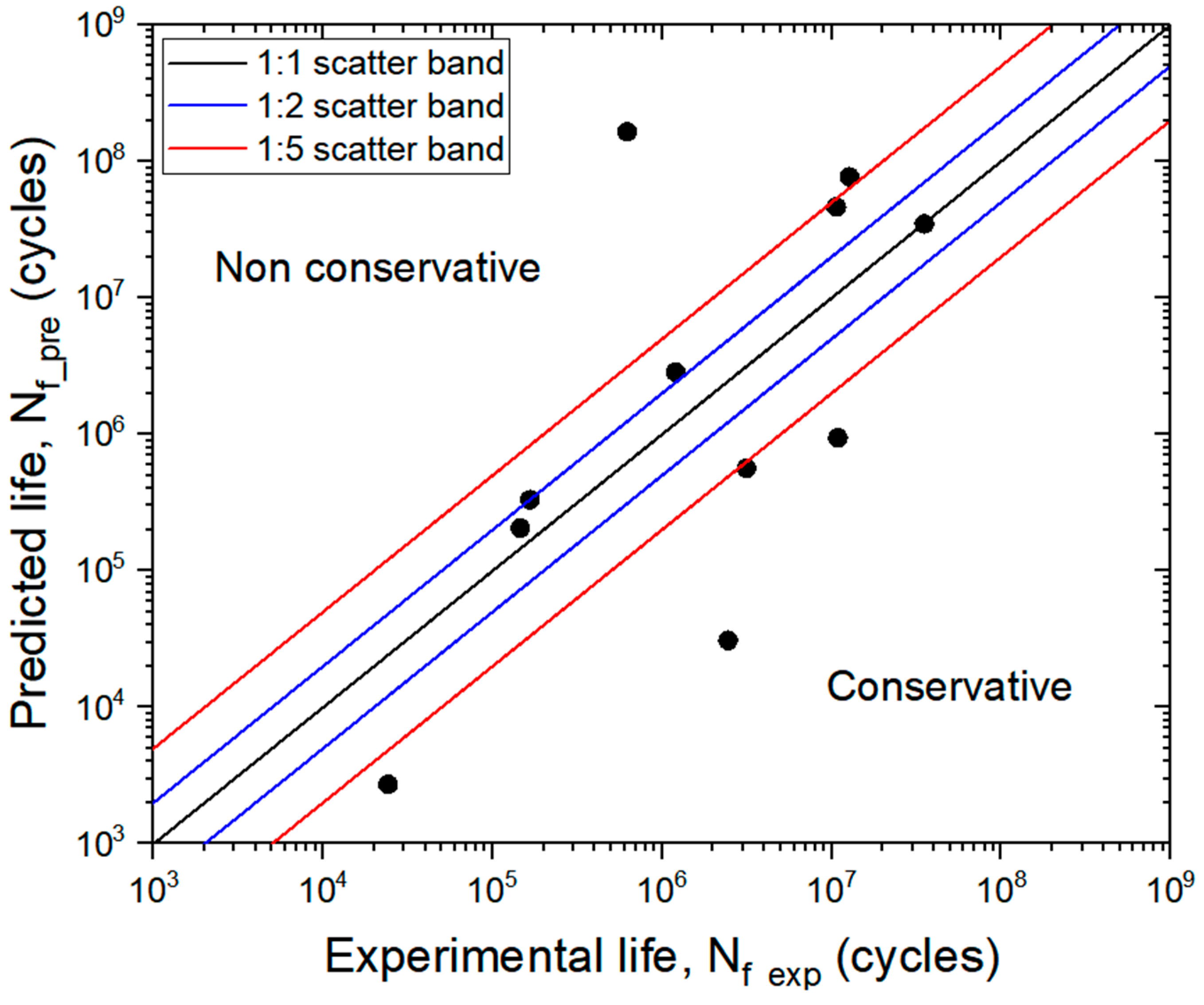
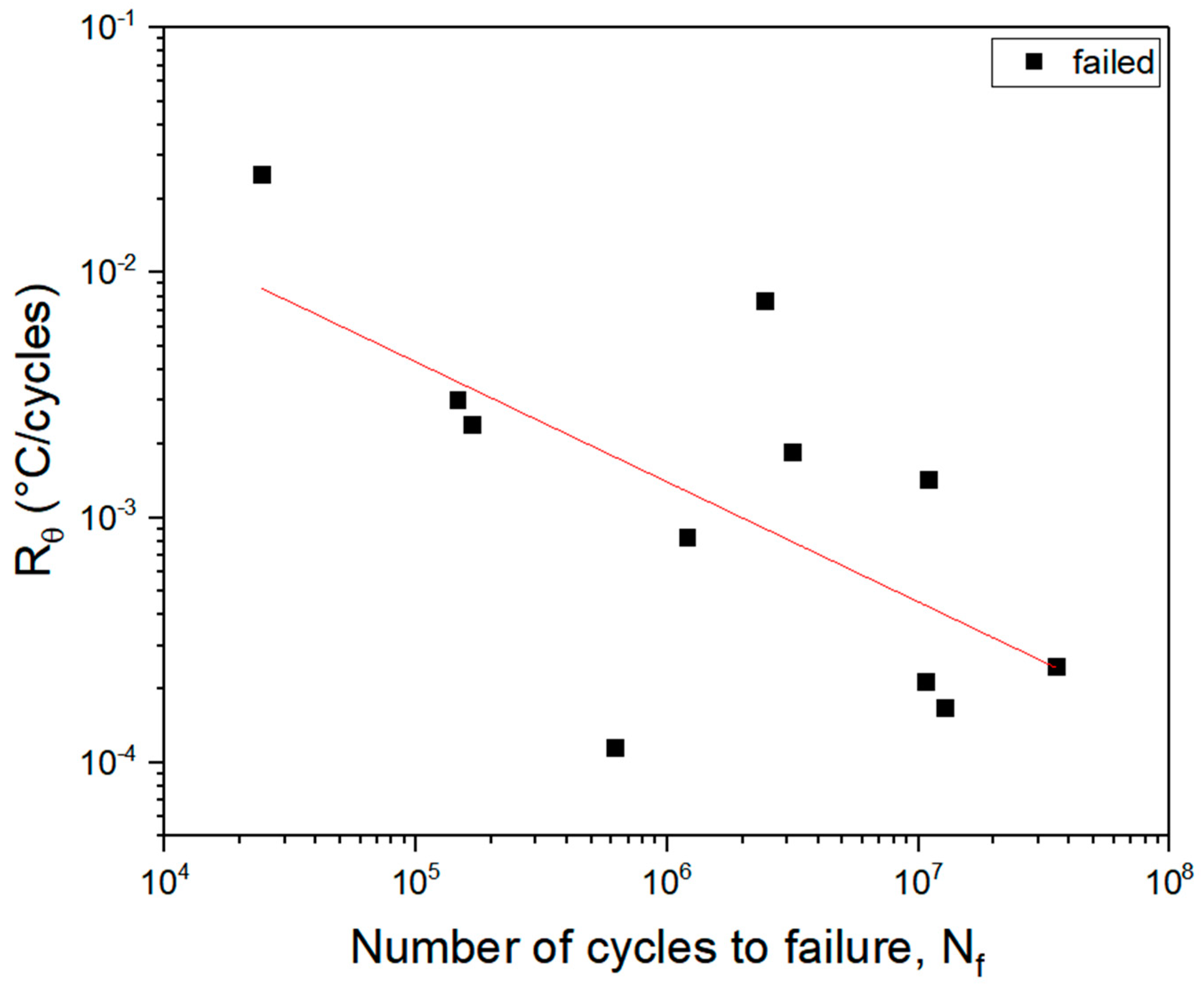
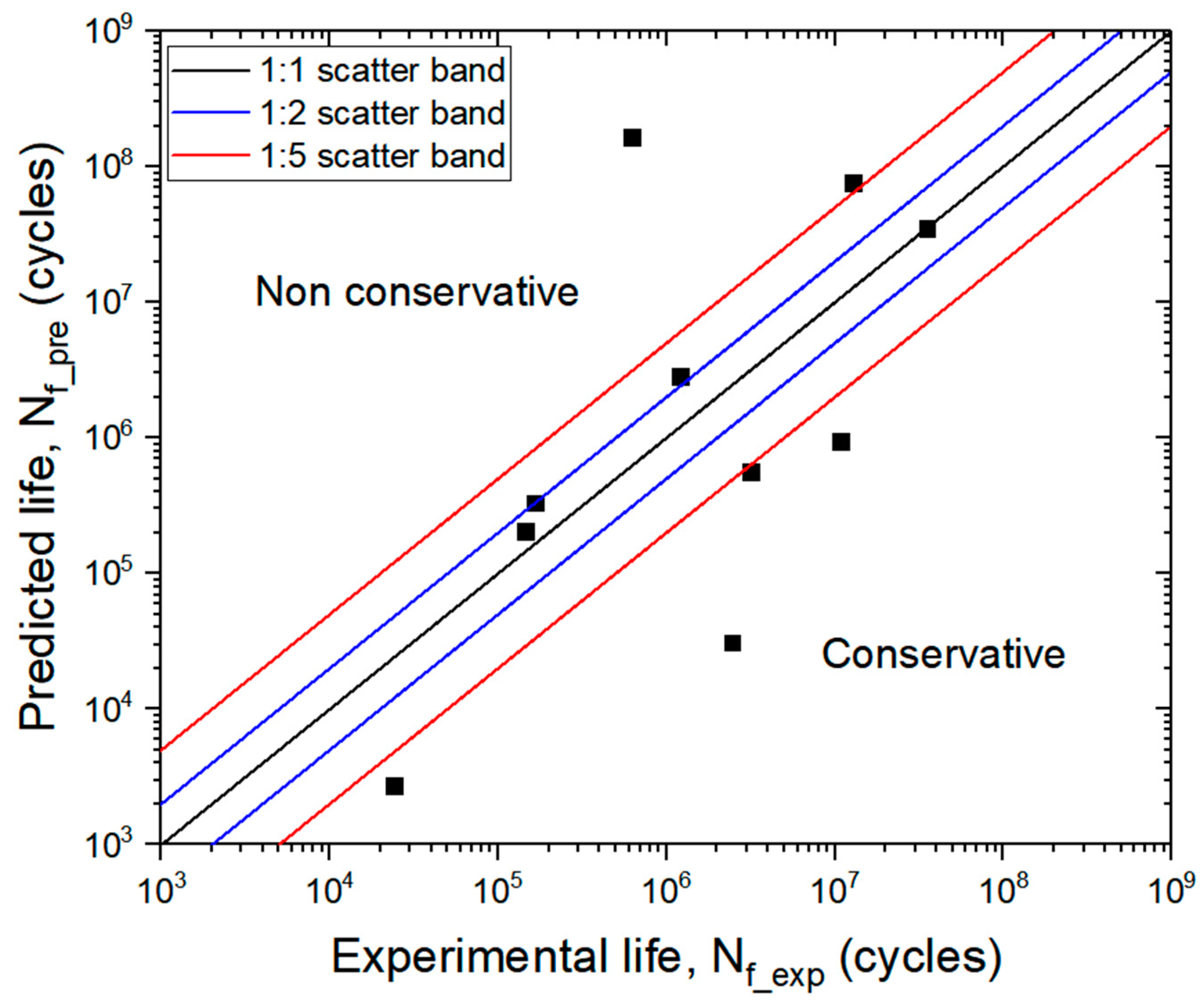

| Failure Criteria | Equations | Reference | Behavior | |
|---|---|---|---|---|
| Jiang et al. | [22] | Is inapt for tests that do not exhibit phase II | ||
| Fargionne et al. | [23] | |||
| Meneghetti et al. | 1° Law of Thermodynamics: | [15,17,18,19] | Requires only phase I and it is applicable to any geometry and type of loading | |
| Amiri and Khonsari | [20,21] | |||
| Steel | Fe (%) | C (%) | Cr (%) | Mo (%) | Ni (%) |
|---|---|---|---|---|---|
| 34CrNiMo6 | 95.1 | 0.38 | 1.51 | 0.24 | 1.75 |
| Steel | σu (MPa) | σy (MPa) | E (GPa) |
|---|---|---|---|
| 34CrNiMo6 | 900 | 760 | 207 |
| Distance of camera to specimen | 0.5 m |
| Room temperature | 20 °C |
| Emissivity | 0.93 |
| Frames per second | 100 |
| Temperature range settings | −40 to 150 °C; 100 to 650 °C; 300 to 2000 °C |
| Pulse–Pause (ms) | feff (Hz) | σa (MPa) |
|---|---|---|
| 300–200 | 11,600.93 | 270 |
| 315 | ||
| 360 | ||
| 405 | ||
| 200–200 | 9680.54 | 270 |
| 315 | ||
| 360 | ||
| 405 | ||
| 200–300 | 7598.78 | 270 |
| 315 | ||
| 360 | ||
| 405 | ||
| 300–500 | 7521.63 | 450 |
| 480 | ||
| 500 | ||
| 520 | ||
| 540 | ||
| 600 | ||
| 110–500 | 3278.68 | 270 |
| 360 | ||
| 110–500 | 3278.68 | 270 |
| (no cooling) | 360 |
| Pulse–Pause (ms) | feff (Hz) | σa (MPa) |
|---|---|---|
| 300–500 | 7521.63 | 360 |
| 420 | ||
| 440 | ||
| 450 | ||
| 460 | ||
| 470 | ||
| 480 | ||
| 500 | ||
| 520 | ||
| 540 | ||
| 600 |
Disclaimer/Publisher’s Note: The statements, opinions and data contained in all publications are solely those of the individual author(s) and contributor(s) and not of MDPI and/or the editor(s). MDPI and/or the editor(s) disclaim responsibility for any injury to people or property resulting from any ideas, methods, instructions or products referred to in the content. |
© 2025 by the authors. Licensee MDPI, Basel, Switzerland. This article is an open access article distributed under the terms and conditions of the Creative Commons Attribution (CC BY) license (https://creativecommons.org/licenses/by/4.0/).
Share and Cite
Teixeira, M.C.C.; Pereira, M.V.S.; Souza, R.F.M.; Lopes, F.R.; da Silva, T.G. Assessment of Fatigue Life and Failure Criteria in Ultrasonic Testing Through Thermal Analyses. Appl. Sci. 2025, 15, 1076. https://doi.org/10.3390/app15031076
Teixeira MCC, Pereira MVS, Souza RFM, Lopes FR, da Silva TG. Assessment of Fatigue Life and Failure Criteria in Ultrasonic Testing Through Thermal Analyses. Applied Sciences. 2025; 15(3):1076. https://doi.org/10.3390/app15031076
Chicago/Turabian StyleTeixeira, Maria Clara Carvalho, Marcos Venicius Soares Pereira, Rodrigo Fernandes Magalhães Souza, Felipe Rebelo Lopes, and Talita Goulart da Silva. 2025. "Assessment of Fatigue Life and Failure Criteria in Ultrasonic Testing Through Thermal Analyses" Applied Sciences 15, no. 3: 1076. https://doi.org/10.3390/app15031076
APA StyleTeixeira, M. C. C., Pereira, M. V. S., Souza, R. F. M., Lopes, F. R., & da Silva, T. G. (2025). Assessment of Fatigue Life and Failure Criteria in Ultrasonic Testing Through Thermal Analyses. Applied Sciences, 15(3), 1076. https://doi.org/10.3390/app15031076







